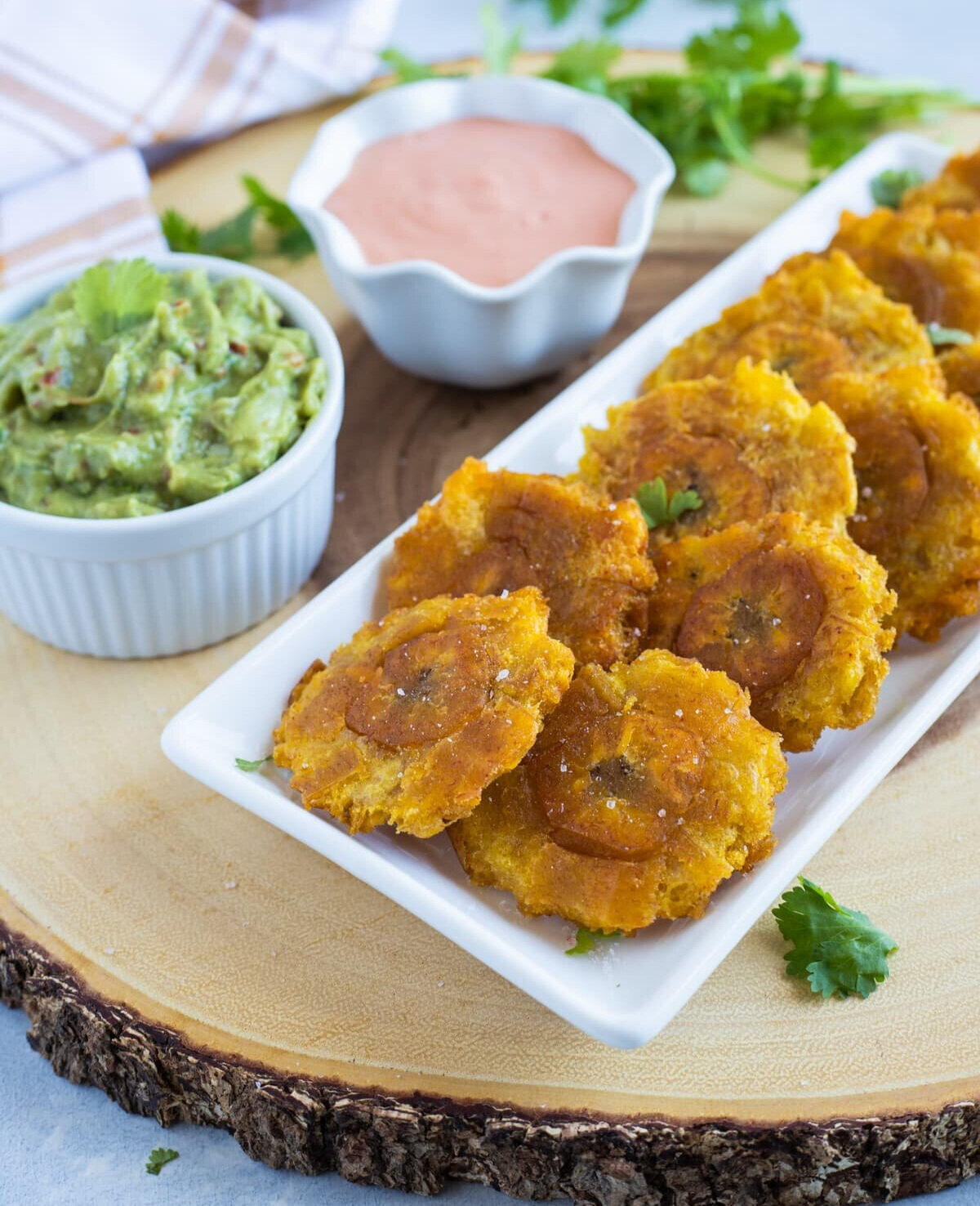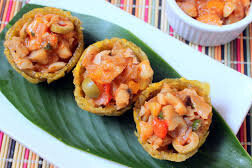
The Ever So Popular: Tostones!
Tostones is by far one of the simplest recipes any person can ever make. Most people probably know them as twice fried plantain, or fried plantains, and it is extremely popular in Latinx households including the Caribbean, South East Asia, and Africa!
Now, I kept debating on how I would create this recipe because Tostones is a great addition to any dish, but you can also make them the perfect appetizer and even the main dish. So many recipes just fluttered in my mind and to be quite honest I was in overload. My heart would not be the happiest little grinch heart it could be in just providing you a basic Tostones recipe. So, get excited mi gente, I’m giving you a two for one special!
We’re going to make the basic Tostones recipe but I’m going to teach you to make them into Rellenos! Rellenos is basically a little cup version that you can stuff with your favorite meat, seafood, or vegan options. But first, you know I have to hit you with a little history lesson!
The first recorded recipe is written in a cookbook titled El Cocinero Puertorriqueño written in 1859 in Puerto Rico. The recipe was titled Fritos Verde at that time, but in continuing my research I learned that frying plantains goes way, way back. To be clear, even though Tostones is extremely popular in the Caribbean and in Latinx households, and as we have a clear date of the first written recipe, it did not originate there.
The plantain is traced back to Africa, specifically Central Africa, West Africa and Southeast Asia, and its birthplace is Malaysia. In these countries, the people would normally cook the Plantain by boiling or frying while it is still green and starchy. Portuguese Colonizers found the plantain in the 1500’s and brought it back to their homeland for planting which was then brought over to the Caribbean islands as well as Latin, and Central America. There is much debate over which place it traveled to first, and where the recipe originated. Based on the dates in each article I read, which are all referenced between 1500 to 1600 and the fact that colonizers were the ones shipping them, they came to the Caribbean, and the America’s during the Salve trade. Which would explain how the recipe came along with the Plantains.
To reiterate, this recipe did not originate in any of the Caribbean, or Americas, it was brought to us from Africa. Punto y Ya!
Now let’s get cooking!
Easy Recipe
Serves about 5 to 6 people
Time: 30 to 40 Minutes
Ingredients:
1. Plantains (Approx. 3 to 4 depending on width)
2. A bowl of salted water (always to taste)
3. Cooking oil (olive oil is great, but any oil works fine I like Vegetable oil)
4. Salt
Materials:
1. 2 Cutting boards (if you don’t have 2, just grab something flat you can smash the plantain with)
2. Knife
3. Cooking gloves
4. Calderon (frying pan works just fine)
5. Napkins/ brown bag
6. Large plate
For the Rellenos:
7. Mortar and Pestle (pilón)
First things first, get your area ready. Place your first cutting board and knife where it feels most comfortable for you. Place the Brown bag or napkin right next to your cutting board Put on your gloves as the plantain will leave stains on your fingers that’s hard to take off. Cut the tips of the plantain off first and lightly and carefully score the plantain vertically down the seams of the plantain. This will help you peel the skin off the banana, take your time with this so you don’t accidently break pieces off. Place the peels on your brown bag or napkin so that it doesn’t stain your countertop.
Once you have peeled all of your plantains, rinse them in water while making sure they are free of any skin. Wash your cutting board and knife and proceed to get ready to chop up your plantain. You can get rid of the gloves now if you’d like and place your salted owl of water next to you. The water should not taste like sea water, but it should be salted to your preference.
Next, cut your plantain in diagonal slices, about 1 in width and place them in the salted water. Repeat this step through out and leave them in the water some time. My minimum is about 15 minutes but the longer you leave them the better. This allows the plantain to crisp but also remain fluffy on the inside.
As it rests, this would be a great time to throw you a freebie. The delicious Mayokechu! Which is a great dipping sauce! This is just a combination of Mayonnaise and Ketchup, hence the name. Combine 3 parts Mayonnaise to 1 part Ketchup, meaning if you add 3 tablespoons of Mayonnaise then ad 1 Tablespoon Ketchup, add a squeeze of lemon juice, and at least a teaspoon of Mojo!
Take your large plate and place a napkin on top. After some time has passed, remove the plantains from the water allowing the water to drain off a bit before frying. Grab your Calderon fill with enough oil to at least cover half of your plantain. Turn your stove on to medium heat, so the oil won’t burn over.
The oil is ready when it has this wave of shininess, or sometimes it will release a fragrance. (Not a fragrance of burning lol). Place your plantains in the making sure they’re not stacked up against each other. Replace the wet napkin on your plate for a dry one. Fry the plantains for a few minutes until a light golden color, and flip. Fry the other side until lightly golden.
Now grab your cutting board and your other flat surface and start smashing your plantains. This is where you can control the thickness of your plantain, you can make them skinnier to mimic a plantain chip or leave them on the thicker side for soups. It’s really up to you. I like mine just in the middle, so I don’t smash them with a heavy hand. Then, place them back onto your plate.
*Here’s the difference for the Rellenos, grab your pilón and rub some oil in the middle as well as on the club. Place the plantain in the middle, with the club pushing down on the center of the plantain gently rocking the club in different directions to create your cup shape. Then follow the next step.
Once you’re done smashing, reheat your oil, (I usually pour out the oil used earlier and pour in clean oil, that’s just me, but you can reuse the previous oil if you’d like.) Once the oil is hot again, place your smashed plantain in letting cook until it reaches a darker golden color.
Remove your delicious golden Tostones and sprinkle with salt while still hot.
Enjoy these tostones with the Mojo from last week, or with your new Mayokechu. You can eat them alone, as a side, or top them with avocado. You can fill your Rellenos with shrimp, bacalao or Ropa Vieja. If you want to step it up and make a meal out of them, turn them into Jibarito’s!! Yum!
Citations:
“Tostones.” 05 Mar. 2021. Web. 12 Mar. 2021.
“Cooking Banana.” Wikipedia. Wikimedia Foundation, 01 Mar. 2021. Web. 12 Mar. 2021.
https://thecaribbeanfoodfiles.wordpress.com/appetizers/fried-plantains/
“Plantain.” Encyclopædia Britannica. Encyclopædia Britannica, Inc. Web. 12 Mar. 2021.










One Comment
Rosse Molina
Fascinating history, scrumptious recipe!!Thank you ?